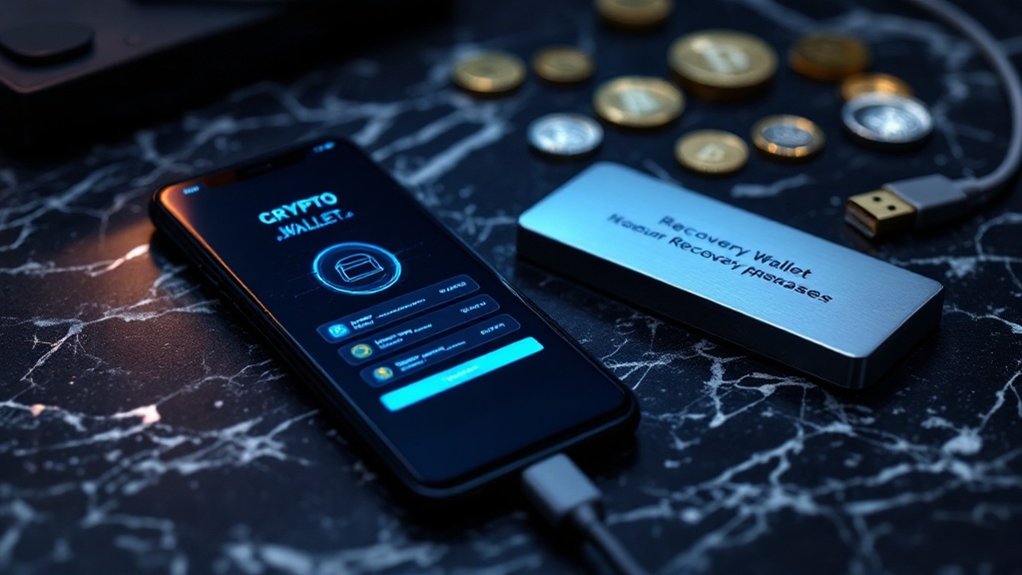Creating a cryptocurrency wallet requires several key steps. First, determine the wallet type needed—hot wallets offer convenience while cold wallets provide improved security. Research reputable providers by examining user reviews and cryptocurrency compatibility. Download from official sources only, verifying digital signatures. Set up strong security measures including unique passwords and two-factor authentication. Store recovery phrases securely in multiple physical locations. Following proper installation and security protocols guarantees safe cryptocurrency storage and transactions for beginners and experienced users alike.

Obtaining a cryptocurrency wallet represents the essential first step for anyone looking to participate in the digital asset ecosystem. Cryptocurrency wallets come in various forms, each offering different levels of security and convenience. Users must first determine which wallet type best serves their needs: hot wallets maintain internet connectivity and provide accessibility, while cold wallets store cryptocurrency offline to maximize security. The wallet functions as a digital security tool that manages access to assets stored on the blockchain network.
Desktop wallets install directly on computers, mobile wallets function as smartphone applications, and web wallets operate through internet browsers. Many users choose to utilize custodial and self-custody options based on their individual security preferences. Understanding the differences helps users make informed decisions, as private keys determine who has ultimate control over the assets.
Selection of a reputable wallet provider requires thorough research into security features, user experiences, and cryptocurrency compatibility. Industry analysts recommend examining user reviews across multiple platforms to identify consistent feedback patterns. Compatibility with desired cryptocurrencies proves critical, as not all wallets support every digital asset.
Researching wallet providers demands scrutiny of security, user feedback, and cryptocurrency support before making your selection.
The wallet's interface should balance functionality with intuitive design, while responsive customer support remains valuable for troubleshooting potential issues.
The installation process begins by accessing the official website or authorized app store, as counterfeit wallets represent a significant security threat. Users should verify digital signatures when available to confirm software authenticity. During setup, creating a strong, unique password serves as the first defense against unauthorized access.
Implementation of two-factor authentication adds an additional security layer that cryptocurrency security experts consider essential.
Security measures extend beyond basic access controls. The wallet's recovery phrase, typically 12-24 random words, functions as the master key to wallet restoration. "Your recovery phrase is the most critical component of wallet security," notes blockchain security specialist James Morrison.
Users should record this phrase physically on paper or metal, storing copies in multiple secure locations away from internet-connected devices. Large cryptocurrency holdings warrant additional protection through hardware wallets that store private keys in secure chips.
Funding the wallet occurs after security implementation. Users receive a unique alphanumeric wallet address to which cryptocurrencies can be transferred. Industry best practice recommends conducting small test transactions before transferring significant amounts.
Blockchain verifiers allow validation of transaction completion by checking the public ledger.
Regular backup verification and software updates maintain wallet integrity over time. Users should familiarize themselves with transaction mechanics, including fee structures and confirmation times. The cryptocurrency ecosystem continues evolving rapidly, necessitating ongoing education about wallet features and security practices.
With proper setup and maintenance, a cryptocurrency wallet provides secure access to the expanding digital asset landscape.
Frequently Asked Questions
What Are the Tax Implications of Using a Crypto Wallet?
Using a crypto wallet itself has no direct tax implications.
However, the transactions performed through the wallet may trigger tax events. Selling cryptocurrency, trading between different cryptocurrencies, and using crypto for purchases all create taxable events that require reporting.
Transferring crypto between personal wallets remains non-taxable.
Users must maintain detailed transaction records showing acquisition dates, cost basis, and fair market value at the time of transactions for proper tax compliance.
Can I Recover My Wallet if I Lose My Device?
Users can recover a wallet after device loss if they have their seed phrase.
This 12-24 word mnemonic serves as the master key to regenerate private keys.
Recovery involves installing a compatible wallet application on a new device, selecting the recovery option, and entering the seed phrase in correct order.
Without this phrase, funds may be permanently inaccessible.
Hardware wallets and encrypted backups provide additional recovery options.
How Do Hardware Wallets Differ From Mobile App Wallets?
Hardware wallets store private keys offline in secure elements, offering superior security against hacking compared to mobile wallets.
Mobile wallets provide greater accessibility for frequent transactions but remain vulnerable to malware.
Hardware wallets typically support thousands of cryptocurrencies, making them ideal for diverse portfolios, while mobile wallets often focus on specific ecosystems.
Cost differs significantly; hardware wallets require upfront investment ($50-$200), whereas mobile applications are typically free to obtain and use.
Are Crypto Wallets Insured Against Hacks or Theft?
Crypto wallets vary significantly in their insurance coverage against theft and hacks. Most exchanges provide limited insurance for hot wallets, while cold storage typically offers more comprehensive protection.
Third-party providers like Coincover and BitGo offer specialized insurance products with coverage limits ranging from $100,000 to $100 million.
However, users should note that policies often exclude losses due to personal negligence, phishing attacks, or password compromise. Insurance terms require careful review before selection.
Which Wallets Support the Most Diverse Range of Cryptocurrencies?
Based on the provided data, Guarda Wallet supports 400,000+ digital assets, while SafePal S1 and Ellipal Titan both accommodate 10,000+ cryptocurrencies across multiple blockchains.
Multi-chain wallets generally offer extensive cryptocurrency support, with Coinomi leading its category at 1,770+ cryptocurrencies across 125 chains.
Hardware wallets like Ledger Nano X (5,500+ cryptocurrencies) and exchange-linked options such as KuCoin Wallet (20,000+ tokens) also provide significant diversity in supported assets.
References
- https://www.bitpay.com/blog/types-of-crypto-wallets
- https://www.bitdegree.org/crypto/tutorials/how-to-get-a-crypto-wallet
- https://www.investopedia.com/terms/b/bitcoin-wallet.asp
- https://itez.com/en/blog/education/how-to-set-up-crypto-wallet
- https://money.com/best-crypto-wallets/
- https://londonlink.io/blog/how-to-create-a-crypto-wallet-a-step-by-step-guide
- https://academy.binance.com/en/articles/crypto-wallet-types-explained
- https://www.investopedia.com/how-to-create-a-crypto-wallet-7500574
- https://www.ledger.com/academy/topics/crypto/types-of-crypto-wallets
- https://graffersid.com/how-to-create-a-crypto-wallet-step-by-step-guide/





